Easy, Peasy, Japanese-y: Benihana and the Question of Cultural Appropriation
- Oops!Something went wrong.Please try again later.
Benihana and the evolution of how Japanese culture is perceived in America.
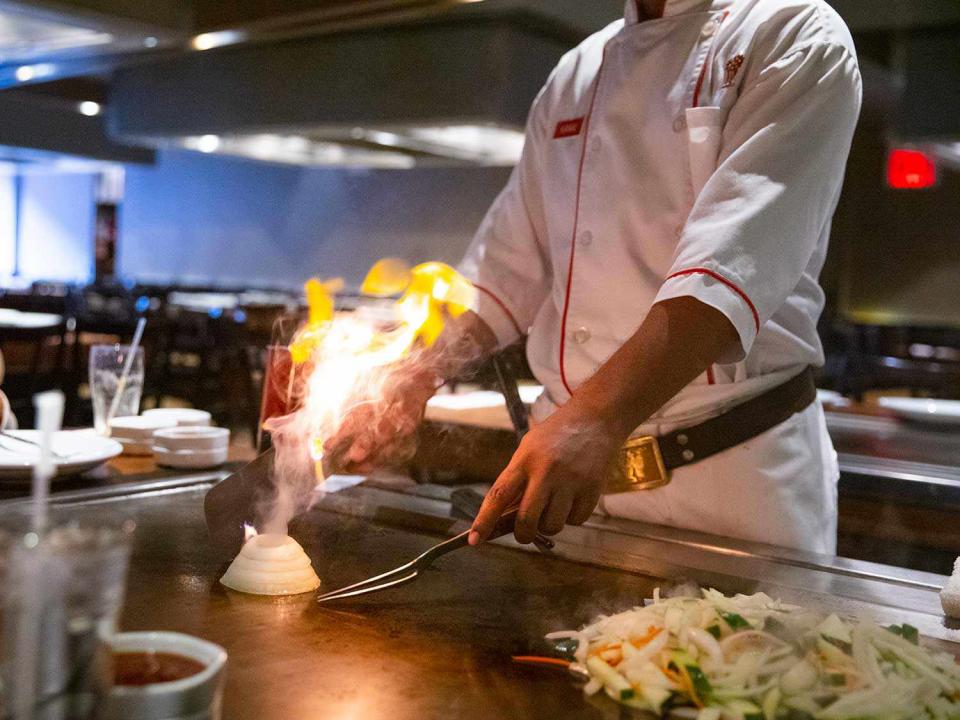
Serious Eats
I love Benihana.
It isn’t the food that does it for me; not the USDA Choice steak and certainly not the chicken (though I’ll admit I’m a sucker for shrimp of any kind, for Benihana’s bad dipping sauces, for the mushrooms that are invariably over- and undercooked at the same time). It isn’t even the exuberant faux friendliness of the service, even if I get a little thrill of excitement whenever the entire floor staff gathers ‘round to sing happy birthday to a table twice, once in English and another in perfunctory if adequate Japanese.
Even though I’ll happily eat a plate of food cut into scat-sized bits or clap along with the staff and their birthday song, and will even, if the spirit calls to me—and it has, frequently—pipe up in Japanese when the time comes, what I love about Benihana is more intangible than the food served or the ambience or the reasonable-for-Manhattan drink prices and specials.
It isn’t even the outright wackiness—the flying shrimp tails or the onion volcano or the egg juggling or any of the other cooking acrobatics.
No, it’s the bare, brutal honesty of the whole experience. I don’t just mean the upselling is as clear as the bland onion soup served with your meal. It’s that every restaurant does what Benihana does but more sneakily and less efficiently; it’s that Benihana murdered the preciousness of the “chef’s table” and cooked it up along with shrimp long before the “chef’s table” ever existed; it’s that Benihana understands most people don’t go out just to eat, just to drink, just for the show; it’s that Benihana knows most people just want a good time, and it only exists to give it to them quickly—no matter how large your group, no matter how many yelling kids, no matter how many drinks you’ve had or ordered, you’re in and out in less time than it takes to see a movie. That is why I admire the man who came up with the concept that Benihana perfected and thereby spawned a legion of copycat “hibachi” Japanese steakhouses across the world.
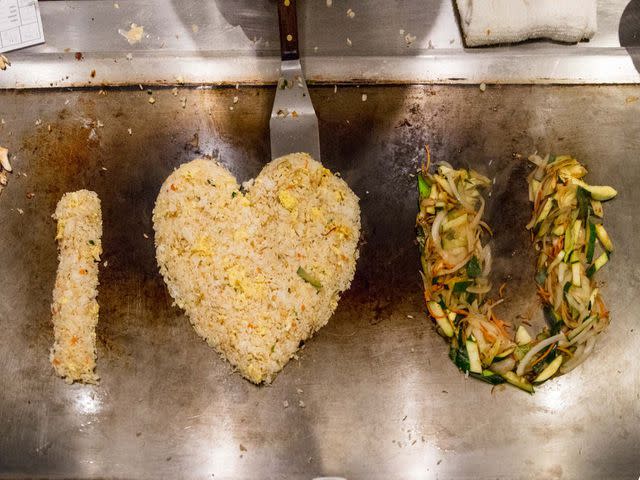
Serious Eats / Vicky Wasik
Now, I don’t usually sit around and think about Benihana and why it’s good, although I often sit around and think about why other restaurants I go to are bad. Which is another way of saying I’ve never found Benihana offensive in the slightest, even though I can’t really say I enjoy the food. But this past summer, social media conspired against my studied complacency about examining the Benihana experience too closely. A reporter tweeted out a photo posted by Donald Trump Jr. on his Instagram: a snap of some fried rice shaped into “I <3 U” on a griddle, over which Trump had typed, incomprehensibly, “My culture is not your fried rice ‘I love you’ with a beating heart sign!!! [crying laughing emoji] #culturalappropriation.”
Oh, no! Politics! In food! In restaurants! And even worse I realized it was possible that all along, over the years—even as I laughed and clapped along as countless Benihana cooks scootched a stack of onions spouting steam across what might as well have been the same flattop, a flattop so long it could very well span my 35 years, and said, or yelled, or merely observed as they are obviously required to: “A choo-choo train”—I had been the unwitting accomplice in some form of awful appropriation of my culture, my culture as a half-Japanese person, yes, but more importantly, my culture as a Japanese-American.
So I decided to go back to Benihana and see for myself.
And, of course, I was disappointed.
Not with the quality of the food, which was not good (as was expected, as was—let’s just say it—preferred, the way I prefer Stove Top Stuffing’s MSG-powdered garlic flavor over any other stuffing); not with the service, since every server performed Benihana’s trademark enthusiastic disinterest admirably; not with the show, of course (no, never with the show).
I was disappointed to fully understand just how un-Japanese the whole Benihana experience is.
Granted, Benihana does serve sushi, but the main attraction, the stuff you order so Benihana cooks can sterilize it mercilessly in front of you and the stuff the place is known for—if it’s known for its food at all, that is—isn’t Japanese.
I suppose Japanese people eat chicken; they eat shrimp, steak, and lobster; they eat fried rice. But the same could be said of any number of other people—the Chinese, say, or Peruvians.
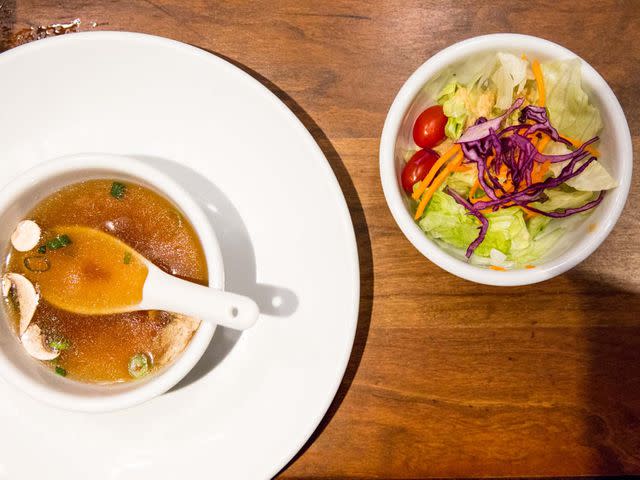
Serious Eats / Vicky Wasik
One might argue that the style of cooking is Japanese, I guess. Not the clacking of utensils, not the volcano onion, and certainly not the flying shrimp, but the bit about cooking meals in front of customers on a griddle. Misono, a restaurant that opened in 1945 in the city of Kobe, Japan, claims to have introduced the idea of cooking things on a cast-iron griddle or steel flattop, which is known in Japanese as teppanyaki, to Japan. The restaurant was primarily popular with Americans stationed there as part of the post–World War II occupation because it sold beef steaks, a food familiar to the occupiers’ palates, and—surprise!—it continues to be popular with American tourists today, presumably for the very same reason.
Of course, Misono cannot claim to have invented the griddle, which is almost as old as fire, and the idea that cooking steaks for the occupying American forces constitutes the creation of a distinct style of Japanese cuisine seems absurd on its face. Also, to get a bit more technical about it, teppanyaki is not typically placed in the category of yoshoku, or Western-influenced Japanese food, like tempura, say, or tonkatsu. Yoshuku dates to the Meiji era, when Japan actively sought to westernize its culture after hundreds of years of self-imposed and rigorously enforced isolation, which eventually led the country to decide to conquer half the globe in the most brutal way imaginable.
All of which is to say, the style of cooking is not very Japanese to begin with.
And so, after my meal, as I walked to the subway, I was left wondering why it is that anyone, anywhere, thinks of Benihana or any of the imitation hibachi** restaurants as Japanese.
** A hibachi is not a flattop upon which one cooks badly. It is a kind of rustic hearth or a charcoal grill, which is also known by the name Ariana Grande mistakenly got tattooed on her hand: shichirin.
Obviously, it has to do with the fact that Benihana’s founder, Hiroaki “Rocky” Aoki, who died in 2008, was Japanese.
He was a character, a person about whom people say “he was larger than life,” whatever that means. And although over the course of this life he did many, many things other than run Benihana—he raced boats, he flew a hot-air balloon across an ocean, he published a soft-core porno mag, he served time for insider trading—Aoki was never an ambassador of Japanese culture, as his obituary in the New York Times claims.
You can see this in his biography, Mr. Benihana: The Rocky Aoki Story by Takahashi Miyuki, which, fittingly, is now only available as a manga. You can also see this in Making It in America: The Life and Times of Rocky Aoki, Benihana’s Pioneer by Jack McCallum, a bit of corporate hagiography commissioned by the company (the 1985 copyright is owned by Benihana of Tokyo, Inc.). Aoki famously told a Times reporter, “The minute I forgot I was Japanese, success began,” and both books reinforce the idea that Aoki possessed qualities that were atypical of Japanese people—he had personality, he valued individuality—and his very un-Japaneseness is what made him successful in America.*
I can’t help but note the McCallum book does this by leaning heavily on racial stereotypes. “Conditioned to fight through the wall of Asian reticence, Americans meeting Rocky for the first time instead find a smiling, warm open-door of a man,” McCallum writes, for example.
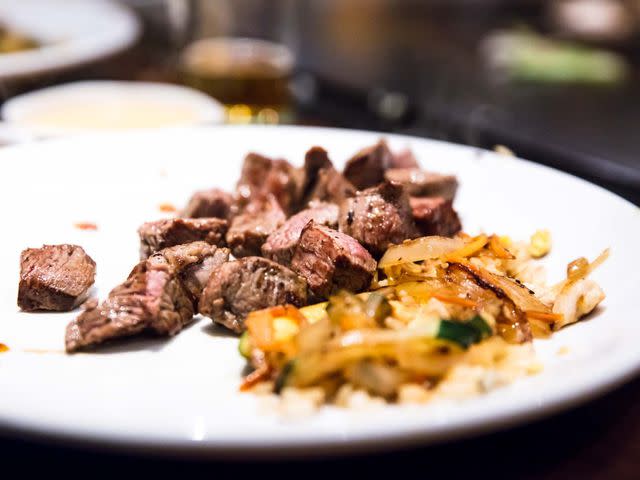
Serious Eats / Vicky Wasik
As the books have it, Aoki tried to set Benihana apart from other Japanese restaurants in the same way he sought to stand apart from his compatriots: by the sheer force of personality. And so, the restaurant chain offers up the odd case of a Japanese businessman who gave the American dining public what he thought they wanted—steak, chicken, shrimp; no “icky, slimy things,” as McCallum quotes him—in an environment that was purposely designed to look exaggeratedly Japanese—the original Benihana’s interior was outfitted to look like a gassho zukuri, or a farmhouse built in a traditional Japanese style—using a campy cooking performance that Aoki created from whole cloth. Benihana was successful because Aoki designed it to appeal to Americans, much as he molded his own personality, even though it looked Japanese.
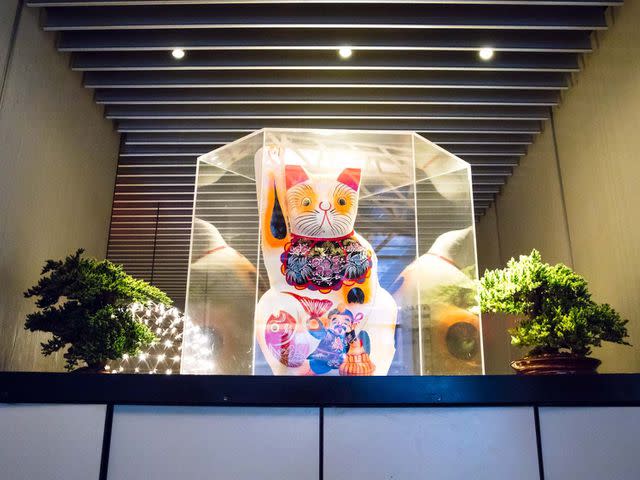
Serious Eats / Vicky Wasik
It doesn’t seem possible to accuse Aoki of appropriating his own culture, although on my most recent visit it occurred to me that the company today might still have to answer for the decor. My memories of Benihana are all stainless steel and bright lights and red and black uniforms, none of which particularly shout “Japan!” to me, but when I went back to Benihana’s Manhattan flagship location, I saw, as if for the first time—maybe actually for the first time—that some tables are bracketed by little raised rock gardens into which wan bonsai trees have been imprisoned; there are lines of decorative ceramic plates along some walls; and there is one of the ugliest maneki nekos I have ever seen, designed by someone who apparently believed good luck could be scared into attendance.
These nods to Japanese-ness are all the more odd when you consider the corporate branding on the menu and its studied aversion to the word “Japanese,” which only appears on the drinks menu. Although, upon consideration, that might just be a case of honest description: the only actually Japanese products on the menu are the sakes, the spirits, the soft drinks, and a small selection of beers.
It doesn’t seem like Benihana needs the aura of being Japanese anymore—being Japanese is entirely ancillary to its product—and it seems like the corporation understands this, given how subdued the Japanese theme is in its branding. And yet it still holds on to a simulacrum of Japanese-ness, one that is just odd enough to provoke a response like the trolling from Donald Trump Jr. and might open up the restaurant chain to accusations of cultural appropriation, no matter how specious.
Since Benihana doesn’t seem to me to actually be guilty of appropriating Japanese culture, what I find more interesting is how the chain clings to the faux-Japanese stuff, and what that says about the way Japanese culture is viewed by many American diners.
When Aoki opened the first Benihana, the Japanese and their culture were largely viewed as a punchline in the United States. The animosity displayed toward Japanese and Japanese-Americans during the World War II era, best exemplified by the placement of about 120,000 Japanese-Americans and Japanese immigrants in concentration camps had given way to a view of Japan as a country that primarily made goods of substandard quality for export. In McCallum’s book, Tad Suga, a Japanese-American friend of Aoki’s, recalls how “it must be made in Japan” was a punchline for one of famed comedian Danny Kaye’s bits. The 1985 movie Back to the Future has a similar gag: When Marty McFly travels back in time to 1955, Doc Brown says of some malfunctioning bit of equipment that it must’ve been made in Japan, to which Marty from 1985 responds with a quizzical look. The dramatic irony of the moment, of course, is that the 1985 audience, like Marty, associated Japan with technological marvels like the Sony Walkman.
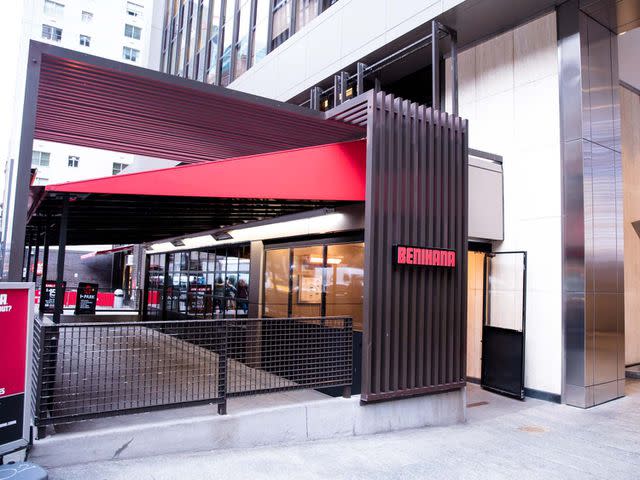
Serious Eats / Vicky Wasik
Aoki’s desire to stand apart from the American stereotypes of Japanese businessmen is entirely understandable, in the same way that it’s understandable that he sought to differentiate his restaurant from other Japanese restaurants: the difference was the selling point. But over the decades during which Benihana became a global chain, the image of Japan evolved further, transforming from a purveyor of substandard goods to the epicenter of both state-of-the-art technology and ruthless business acumen as companies like Sony and Toyota seemed to achieve global dominance. And now, even as Japan’s rising star has ceded its place to China and South Korea, it still retains a positive, almost beatific glow in the American imagination.
The transformation of the popular conception of Japanese culture in this country from the World War II era to the present is entirely unique. Japan was once an enemy so menacing that it warranted putting its emigrants in concentration camps; now it exists as a kind of benign oddity in the American mind. Today, the Japanese are widely known for their food, their cleanliness, their attention to detail, their customer service, and their comics and cartoons, which serve to reinforce the image of Japan as a pleasant, albeit weird, place populated with correspondingly weird and pleasant people—a caricature that is about two parts Marie Kondo, one part Jiro Ono, and one part Haruki Murakami.
This caricature is relentlessly reinforced by the country's admirers in the Western press. We are told the Japanese are just so positive or that we Americans would do well to emulate them, despite regular news reports about the society's deeply ingrained misogyny, exploitative work culture, and the rampant xenophobia that finds its expression in its suicidally exclusionary immigration policies, which is why it’s held up as an exemplar by ethno-nationalists the world over. And let’s not forget the jingoism evident in the pilgrimages and tributes sent by Japanese heads of state to a shrine dedicated to the few token war criminals prosecuted in the aftermath of World War II, which justifiably enrages Japan's neighbors.
All of which is to say, Japan is a complicated country with a troubled culture, but for most Americans, it is merely the source of products that they are willing to pay a premium to possess, not because they are technologically more advanced or qualitatively better, but because they have a certain aesthetic, whether it’s animated cartoons, middle-brow fiction, or scented oil dispensers guaranteed to spark joy for years to come.
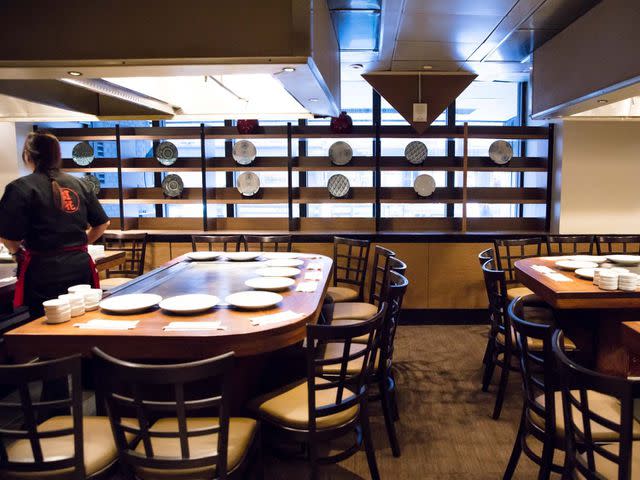
Serious Eats / Vicky Wasik
Nowhere is this tendency to overvalue Japanese-ness more evident than in restaurant culture, which is why it would be silly for Benihana to ditch any references to its legitimately Japanese origin, even if it doesn’t need them. Japanese stuff sells, and it would be malpractice for any restaurateur not to take advantage of the fact that many Americans are more willing to spend money on “small plates” at an “izakaya” than on bar food at a restaurant and bar. To illustrate this point, let us turn to another global chain of restaurants that has distinctly Japanese branding but sells pretty un-Japanese stuff: David Chang’s Momofuku Group.
When the group opened one of its newer restaurants, Majordomo, in Los Angeles, the fruit plate on the menu raised some eyebrows. Chang had famously criticized California restaurants for similarly stripped-down dishes, and the new dessert item seemed to be a retreat from his previous position. But what caught my eye as I read that little news item was the following lines: "The first night the restaurant ran the fruit plate, only one sold. But then Johnson decided to freeze the grapes and make the dish look more Japanese. In its current iteration, it looks like the fruits served at the end of a kaiseki menu and is also reminiscent of the ceremonial fruits on display at specialty vendors. It’s selling better now."
One could argue this is an example of Chang—a Korean-American—and his colleagues of appropriating Japanese culture, but in my view that would be wrong. Chang, like Aoki, is only giving the American dining public what it wants. And what most Americans want is the elements of Japanese culture that they like—the nice-looking things; the tender, palatable foods; the weird stuff, but nothing icky or slimy. What most Americans want isn’t “Japanese”: what they want is Japanese-y.
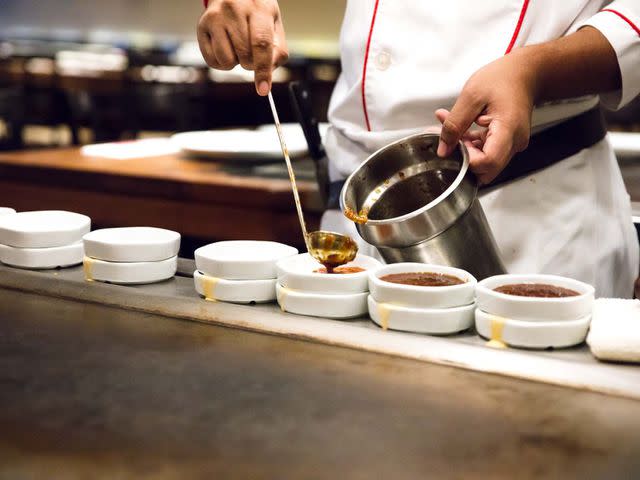
Serious Eats / Vicky Wasik
February 2019
Read the original article on Serious Eats.

